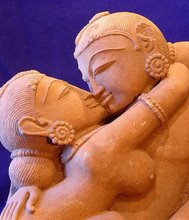HIV Infection and Acquired Immunodeficiency Syndrome (AIDS)
More details/Information for students
Definition
Stages of infection
Transmission
How HIV is spread
How HIV is not spread
Blood products
Sexual activity: Vaginal intercourse, Anal intercourse, Oral sex, Non-penetrative sex
Monday, August 28, 2006
Sunday, August 13, 2006
how and why we humans fall in love.
Dating & Relating Who knew? Crazy love facts
Wait till you hear the fascinating facts scientists have uncovered about Whose relationship history includes...
Whose faith is...
Custom search
The secret to a romantic night is…So it’s date night and you want to set the mood for romance…what’s the right plan to make? Interestingly, you should go to a movie, but not any old flick. If you want kisses after the credits roll, then a romantic chick flick should be your choice, according to a recent study by the University of Michigan. Researchers reached this conclusion after testing the hormone levels of three different groups of men and women who were shown a variety of movies. One group watched a romantic scene from The Bridges of Madison County, a second viewed a violent portion of The Godfather: Part II, and a third was shown a documentary on the Amazon rainforest. While the viewers watching the rainforest footage experienced no hormonal changes, researchers found that The Bridges of Madison County caused a surge in both men’s and women’s levels of progesterone, a hormone that triggers the urge to cuddle. “Progesterone is known to have anxiety-reducing, soothing effects,” explains Oliver C. Schultheiss, associate professor of psychology at the University of Michigan and co-author of the study. In this way, progesterone can pave the way for romance and help couples bond, he says. Should you wed the first person you fall for?How many people should you wine and dine before you can feel confident enough to say you’ve met your one and only? Believe it or not, mathematics has the answer: A dozen. “Check out and reject 12 people, then pick the next best that comes along, and you’re likely to have a very good match on your hands,” says Clio Cresswell, a mathematician and author of Mathematics and Sex. That’s because when it comes to decision-making, formulas reveal that your chances of picking the right answer improve as you expose yourself to more options. But there does come a point when you are over-researching: If you date and reject 30 or more potential mates, “you've probably met someone that you could possibly have been more than happy with, and passed them over,’ notes Cresswell. The best time to bondMany people agree with John Gray—men are from Mars, and women from Venus. However, a new study suggests that there is a brief time in our dating lives when men and women are pretty much from the same planet. It's when we first fall in love. For this, you can thank your hormones, which, researchers from the University of Pisa in Italy found out, fluctuate like mad when a new relationship blooms. When guys are smitten, they experience a drop in their body’s levels of testosterone, a hormone linked to aggressive, sometimes domineering behavior. Meanwhile, love-struck women get a testosterone boost. “Men, in some way, become more like women, and women become like men,” researcher Donatella Marazziti explained. And there’s a very good reason for this hormonal gender-bending: We’re more likely to have a rapport with someone who shares our personality traits. This blissful, two-peas-in-a-pod feeling doesn’t last forever, though. When researchers tested subjects one year later, they found that men’s and women’s testosterone levels had diverged and returned to their pre-relationship levels. Is it lust or love?If you’re swooning over your new sweetie, you may think you’re deeply in love. Friends, however, may say, “You’re just in lust.” Who’s right? Researchers have recently found evidence that people can distinguish between true romance and plain old sexual attraction. For the study, scientists performed MRIs on men and women as they looked upon photos of the person they were in love with and photos of acquaintances (both attractive and less attractive ones). The results showed that the two sets of photos affected the brain very differently: Photos of loved ones triggered more activity on the right side of the brain (an area associated with romantic emotions) than did the other photos; photos of extremely attractive people triggered more activity on the left side of the brain (a hotbed for sexual urges) than did the photos of subjects’ beloveds. What this suggests, says study author Arthur Aron, Ph.D., a professor of psychology at the State University of New York-Stony Brook, is that the emotions of love and lust are more distinct than we think, and that people can indeed discriminate between the two. Tell that to your cynical friends! And your soul mate’s name is…Would you choose a romantic partner because his or her name sounds like yours or because you share the same initials? Scoff all you like, but a new study suggests people do just that. When a team of researchers led by John T. Jones, Ph.D., of the United States Military Academy checked out marriage records stretching back to the 1800s, they found a significant number of couples in which the woman’s maiden name began with the same letter as the man’s surname. To further test the research, the team conducted an experiment in which male college students were first asked to write about a flaw of theirs (we’ll explain why in a minute). Then they were asked to evaluate women’s personal ads in which the full first name and first three letters of their last name were listed. Subjects, it turns out, were especially drawn to profiles in which the names resembled their own. Why, exactly, do matching monikers prove so magnetic? In a nutshell, because people tend to have a positive association with their own name—and this need for familiarity increases when people are under stress or forced to dwell on their shortcomings. “Especially when they’re anxious, people may gravitate toward self-relevant symbols,” Jones explained. “We think there’s something about these symbols that makes people feel more secure.” Added bonus: If you two last for the long haul, you sure can save on monogramming costs. Reported by Judy Dutton, Lisa Cericola, Elise Nersesian, Jessica Brown, and Laura Schaefer.
Article courtesy of Happen magazine, www.happenmag.com.
Wait till you hear the fascinating facts scientists have uncovered about Whose relationship history includes...
Whose faith is...
Custom search
The secret to a romantic night is…So it’s date night and you want to set the mood for romance…what’s the right plan to make? Interestingly, you should go to a movie, but not any old flick. If you want kisses after the credits roll, then a romantic chick flick should be your choice, according to a recent study by the University of Michigan. Researchers reached this conclusion after testing the hormone levels of three different groups of men and women who were shown a variety of movies. One group watched a romantic scene from The Bridges of Madison County, a second viewed a violent portion of The Godfather: Part II, and a third was shown a documentary on the Amazon rainforest. While the viewers watching the rainforest footage experienced no hormonal changes, researchers found that The Bridges of Madison County caused a surge in both men’s and women’s levels of progesterone, a hormone that triggers the urge to cuddle. “Progesterone is known to have anxiety-reducing, soothing effects,” explains Oliver C. Schultheiss, associate professor of psychology at the University of Michigan and co-author of the study. In this way, progesterone can pave the way for romance and help couples bond, he says. Should you wed the first person you fall for?How many people should you wine and dine before you can feel confident enough to say you’ve met your one and only? Believe it or not, mathematics has the answer: A dozen. “Check out and reject 12 people, then pick the next best that comes along, and you’re likely to have a very good match on your hands,” says Clio Cresswell, a mathematician and author of Mathematics and Sex. That’s because when it comes to decision-making, formulas reveal that your chances of picking the right answer improve as you expose yourself to more options. But there does come a point when you are over-researching: If you date and reject 30 or more potential mates, “you've probably met someone that you could possibly have been more than happy with, and passed them over,’ notes Cresswell. The best time to bondMany people agree with John Gray—men are from Mars, and women from Venus. However, a new study suggests that there is a brief time in our dating lives when men and women are pretty much from the same planet. It's when we first fall in love. For this, you can thank your hormones, which, researchers from the University of Pisa in Italy found out, fluctuate like mad when a new relationship blooms. When guys are smitten, they experience a drop in their body’s levels of testosterone, a hormone linked to aggressive, sometimes domineering behavior. Meanwhile, love-struck women get a testosterone boost. “Men, in some way, become more like women, and women become like men,” researcher Donatella Marazziti explained. And there’s a very good reason for this hormonal gender-bending: We’re more likely to have a rapport with someone who shares our personality traits. This blissful, two-peas-in-a-pod feeling doesn’t last forever, though. When researchers tested subjects one year later, they found that men’s and women’s testosterone levels had diverged and returned to their pre-relationship levels. Is it lust or love?If you’re swooning over your new sweetie, you may think you’re deeply in love. Friends, however, may say, “You’re just in lust.” Who’s right? Researchers have recently found evidence that people can distinguish between true romance and plain old sexual attraction. For the study, scientists performed MRIs on men and women as they looked upon photos of the person they were in love with and photos of acquaintances (both attractive and less attractive ones). The results showed that the two sets of photos affected the brain very differently: Photos of loved ones triggered more activity on the right side of the brain (an area associated with romantic emotions) than did the other photos; photos of extremely attractive people triggered more activity on the left side of the brain (a hotbed for sexual urges) than did the photos of subjects’ beloveds. What this suggests, says study author Arthur Aron, Ph.D., a professor of psychology at the State University of New York-Stony Brook, is that the emotions of love and lust are more distinct than we think, and that people can indeed discriminate between the two. Tell that to your cynical friends! And your soul mate’s name is…Would you choose a romantic partner because his or her name sounds like yours or because you share the same initials? Scoff all you like, but a new study suggests people do just that. When a team of researchers led by John T. Jones, Ph.D., of the United States Military Academy checked out marriage records stretching back to the 1800s, they found a significant number of couples in which the woman’s maiden name began with the same letter as the man’s surname. To further test the research, the team conducted an experiment in which male college students were first asked to write about a flaw of theirs (we’ll explain why in a minute). Then they were asked to evaluate women’s personal ads in which the full first name and first three letters of their last name were listed. Subjects, it turns out, were especially drawn to profiles in which the names resembled their own. Why, exactly, do matching monikers prove so magnetic? In a nutshell, because people tend to have a positive association with their own name—and this need for familiarity increases when people are under stress or forced to dwell on their shortcomings. “Especially when they’re anxious, people may gravitate toward self-relevant symbols,” Jones explained. “We think there’s something about these symbols that makes people feel more secure.” Added bonus: If you two last for the long haul, you sure can save on monogramming costs. Reported by Judy Dutton, Lisa Cericola, Elise Nersesian, Jessica Brown, and Laura Schaefer.
Article courtesy of Happen magazine, www.happenmag.com.
Subscribe to:
Posts (Atom)



